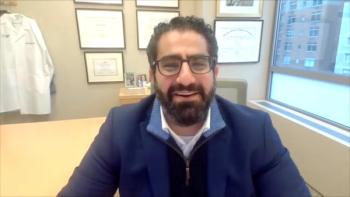
2 Immunotherapies Show Comparable Benefits in Extensive-Stage Small Cell Lung Cancer
Key Takeaways
- PD-1 and PD-L1 inhibitors combined with chemotherapy significantly improve survival in ES-SCLC compared with chemotherapy alone.
- No significant difference in overall survival or progression-free survival was found between PD-1 and PD-L1 inhibitors.
When added to chemotherapy, researchers found no significant difference in overall or progression-free survival between PD-1 and PD-L1 inhibitors.
Patients with extensive-stage
The study was published in
“The present study enriched the research data on PD-1 inhibitors in the first-line treatment of ES-SCLC after the inclusion of the results of tislelizumab and toripalimab, but PD-1 + Chemo versus PD-L1 + Chemo did not produce a significant improvement in OS and PFS,” the authors said.
Patients who received PD-1 plus chemotherapy had a 29% reduced risk of death compared with those receiving chemotherapy alone, while those treated with PD-L1 plus chemotherapy saw a 28% reduction in mortality risk. Both treatment combinations significantly improved PFS, increasing by 41% with PD-1 inhibitors and 27% with PD-L1 inhibitors, compared with chemotherapy alone.
In indirect comparisons, researchers did not find a significant advantage of one inhibitor over the other in terms of efficacy (OS: HR, 0.99; 95% CI, 0.86-1.1; PFS: HR, 0.80; 95% CI, 0.61-1.0) or safety (HR, 1.0; 95% CI, 0.93-1.1) when added to chemotherapy. They noted that more research is needed to see how similar or different their efficacy and safety are in treating ES-SCLC.
Regarding safety, neither PD-1 nor PD-L1 inhibitors significantly increased the incidence of severe treatment-related adverse events (TRAEs) compared with chemotherapy alone, the authors found. The likelihood of experiencing grade 3 or higher TRAEs was nearly identical between the 2 treatments (HR, 1.0; 95% CI, 0.93-1.1), reinforcing the idea that both options provide added survival benefits without additional safety concerns. However, as PD-1 inhibitors block the interaction between PD-1 and its ligands, PD-L1 and PD-L2, the authors said the treatment option may lead to a higher incidence of AEs.2
Additionally, a subgroup analysis indicated that patients with ES-SCLC with higher PD-L1 expression levels (≥ 1%) may benefit slightly more from PD-1 inhibitors, while those with lower PD-L1 expression (< 1%) appeared to respond better to PD-L1 inhibitors.1 However, researchers cautioned against using PD-L1 expression as a definitive marker for treatment selection until further research confirms these findings.
A 2020 meta-analysis published in
While PD-1 and PD-L1 inhibitors combined with chemotherapy significantly improved survival in ES-SCLC, they were also linked to an increased risk of immune-related AEs (imAEs). Compared with chemotherapy alone, patients who received either combination therapy saw an almost quadrupled increase in all-grade imAEs (HR, 3.77; 95% CI, 1.99-7.15; P < .0001) and a sevenfold increase in severe imAEs, defined as grade 3 or higher (HR, 7.01; 95% CI, 2.48-19.81; P = .0002).
The current study did not assess how these treatments impact quality of life, an important factor for patients.1 According to the authors, additional research with larger, well-controlled clinical trials is needed to confirm these findings.
References
- Wang K, Zheng C, Chen X, et al. Updated Bayesian network meta-analysis on the efficacy and safety of PD-1 versus PD-L1 inhibitors in first-line treatment with chemotherapy for extensive-stage small-cell lung cancer. Front Oncol. 2025;14:1455306. doi:10.3389/fonc.2024.1455306
- Parvez A, Choudhary F, Mudgal P, et al. PD-1 and PD-L1: architects of immune symphony and immunotherapy breakthroughs in cancer treatment. Front Immunol. 2023;14:1296341. doi:10.3389/fimmu.2023.1296341
- Zhang S, Li S, Cheng Y. Efficacy and safety of PD-1/PD-L1 inhibitor plus chemotherapy versus chemotherapy alone as first-line treatment for extensive-stage small cell lung cancer: a systematic review and meta-analysis. Thorac Cancer. 2020;11(12):3536-3546. doi:10.1111/1759-7714.13698
Newsletter
Stay ahead of policy, cost, and value—subscribe to AJMC for expert insights at the intersection of clinical care and health economics.















































